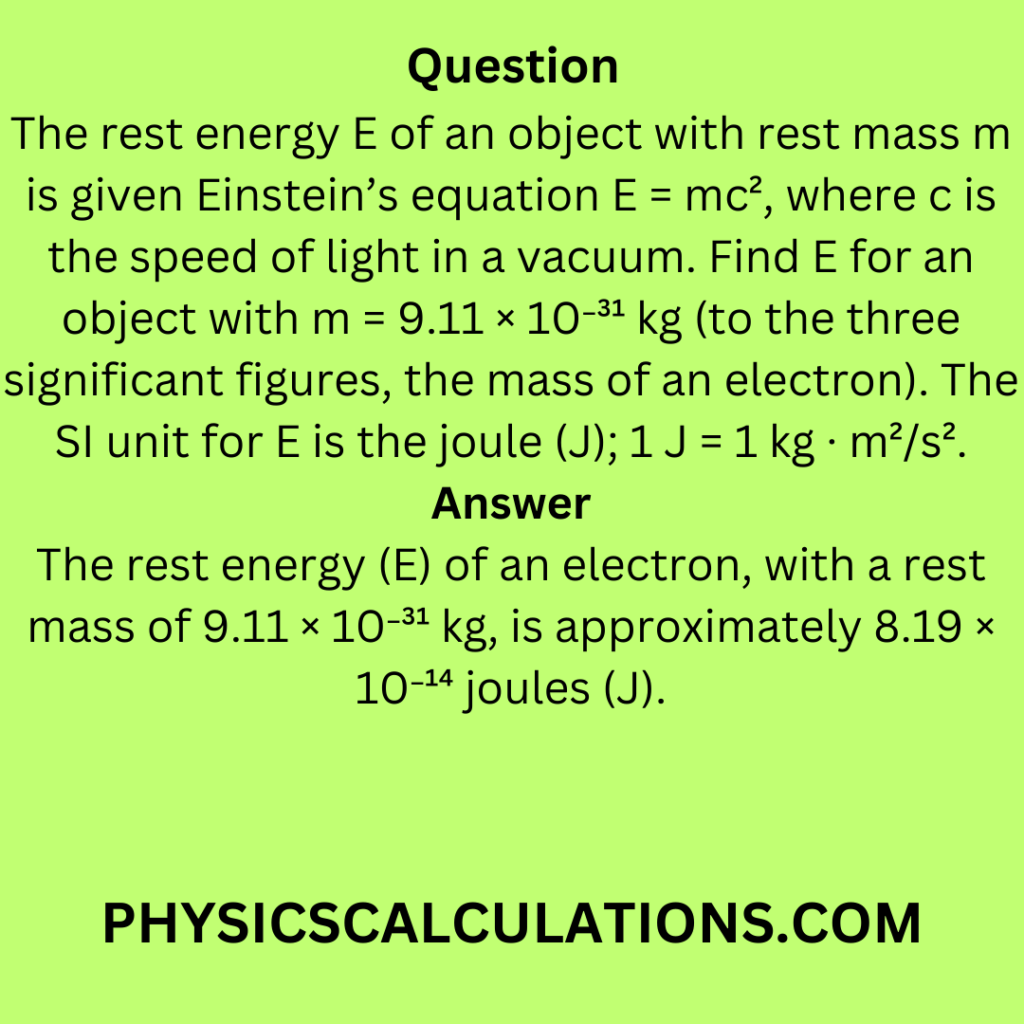Question
The rest energy E of an object with rest mass m is given Einstein’s equation
E = mc²,
where c is the speed of light in a vacuum. Find E for an object with m = 9.11 × 10⁻³¹ kg (to the three significant figures, the mass of an electron). The SI unit for E is the joule (J); 1 J = 1 kg · m²/s².
Answer
The rest energy (E) of an electron, with a rest mass of 9.11 × 10⁻³¹ kg, is approximately 8.19 × 10⁻¹⁴ joules (J).

Explanation
Our task is to calculate the rest energy (E) of an object with a given rest mass (m). We will use Einstein’s famous equation, E = mc². The given mass is that of an electron, which is m = 9.11 × 10⁻³¹ kg, rounded to three significant figures.
Step 1: Understand the Problem
First, it’s important to understand the significance of Einstein’s equation, E = mc². This equation describes the relationship between mass and energy. Additionally, it reveals that even an object at rest possesses energy due to its mass. Therefore, the speed of light in a vacuum, denoted as ‘c,’ is a fundamental constant in physics. It has a value of approximately 299,792,458 meters per second.
You may also like to read:
The official world land speed record is 1228.0 km/h, set on October
Step 2: Applying the Formula
To find the rest energy E of the electron, we will use the given mass (m) and Einstein’s equation, E = mc². It’s noteworthy that the unit of energy in the International System of Units (SI) is the joule (J), and 1 J is defined as 1 kg·m²/s².
Let’s calculate E for the electron:
E = mc²
E = (9.11 × 10⁻³¹ kg) × (299,792,458 m/s)²
Step 3: Perform the Calculation
Now, we’ll perform the calculation to find the rest energy (E) of the electron.
E = (9.11 × 10⁻³¹ kg) × (299,792,458 m/s)²
E ≈ 8.187 × 10⁻¹⁴ J
Step 4: Rounding to Three Significant Figures
The mass of the electron was given to three significant figures, so we should round the result to the same level of precision:
E ≈ 8.19 × 10⁻¹⁴ J
Therefore, the rest energy (E) of the electron is 8.19 × 10⁻¹⁴ joules (J). This means that even though electrons are tiny particles, they possess a significant amount of rest energy due to their mass, as predicted by Einstein’s groundbreaking equation.
Conclusion:
In accordance with Einstein’s famous equation E = mc², which relates energy (E) to mass (m) and the speed of light in a vacuum (c), we have calculated the rest energy of an electron. The electron, with a rest mass of 9.11 × 10⁻³¹ kg, possesses a rest energy of approximately 8.19 × 10⁻¹⁴ joules (J).
This result underscores the profound implications of Einstein’s theory of special relativity, demonstrating that even particles with relatively small masses, such as electrons, harbor a considerable amount of energy. The conversion from mass to energy, as described by E = mc², is a foundational concept in modern physics and has led to a deeper understanding of the fundamental relationship between matter and energy.